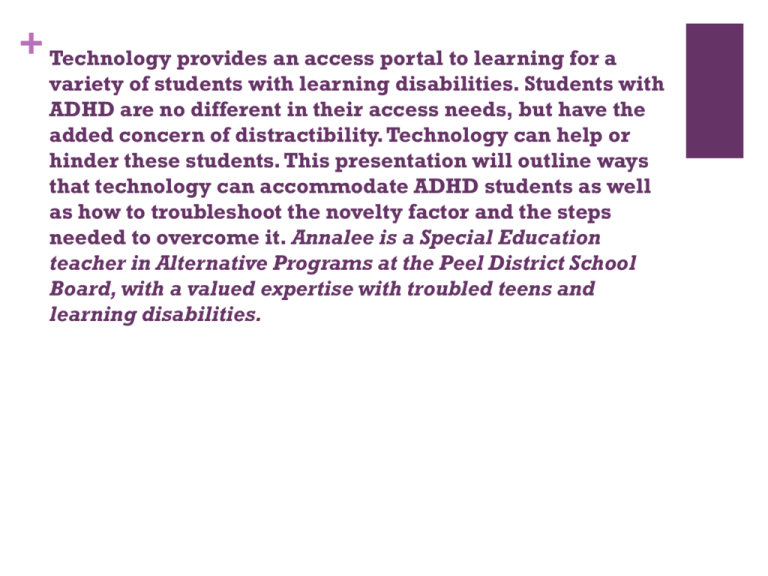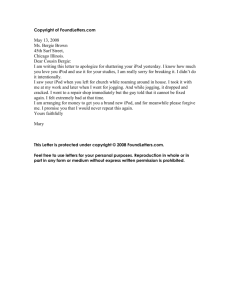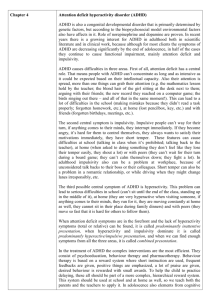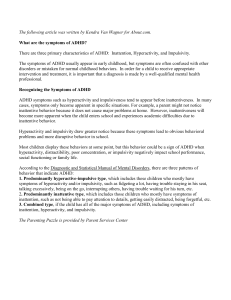ADHD and technology presentation
advertisement

+ Technology provides an access portal to learning for a variety of students with learning disabilities. Students with ADHD are no different in their access needs, but have the added concern of distractibility. Technology can help or hinder these students. This presentation will outline ways that technology can accommodate ADHD students as well as how to troubleshoot the novelty factor and the steps needed to overcome it. Annalee is a Special Education teacher in Alternative Programs at the Peel District School Board, with a valued expertise with troubled teens and learning disabilities. + + GOALS FOR SESSION: Item 1 • Introduction Item 2 • ADHD and Executive Functioning Item 3 • Pairing Strategies and Technology Item 4 • Choosing the Right Technology Item 5 • Conclusion and Questions + Attention- Deficit/Hyperactivity Disorder (ADHD) is a neurobiological disorder interferes with an individual's capacity to : - regulate activity level (hyperactivity) - inhibit behavior (impulsivity) - attend to the task at hand (inattention)1 + AD/HD and Complicating Factors + Executive Functions…Where it all falls apart. Executive functions - skills that are crucial to school performance, behavioral control, and social interactions. Technology can support weaknesses in executive functioning – this is the HELPING TOOL side the novelty of the technology leads to THE … + …HIGHWAY TO DISTRACTIO + What are the 4 Executive Functions? For the purpose of this presentation, executive functions are considered to include the following: Problem Define Solving (Tasks/Activities/Situations) the problem Set a goal Propose strategies Prioritize, organize, sequence the steps/skills/materials Estimate and allocate time needed + Flexibility (Cognitions/Behaviors/Emotions) Adapt/change or shift responses, behavior, and emotional reactions when faced with new, unfamiliar, or unexpected situations Initiation/Execution (Tasks/Activities) Begin and carry out a task or activity without prompts Self-Monitoring/Use of feedback/Self Correction Identify and evaluate one’s own performance and behavior before, during, after a situation + Technology = Compensatory Tool Our goal is to integrate the mediums and tools already used by students in innovative ways – with ADHD that innovation goal, is accommodating the weakness in executive functions Key to a successful integration is an effective introduction – we want to change the way students see technology, therefore changing how they use it How to introduce technology in learning environments? + How do we strategize against the novelty factor… BE PREPARED! Recognize and accept that novelty is inevitable – accept it before it discourages you Novelty works to our advantage – kids learn when they are excited, engaged and at PLAY– what could be more fun than a new laptop or IPOD? Framing the technology in learning terms…introduce the learning strategy first, then build on how to integrate the technology to improve the strategy + Teaching a Technology Strategy – a work in PROCESS DESCRIBE the strategy and CONNECT the strategy to the technology. MODEL how to use the strategy with the technology – use a data projector, with a walkthrough on screen STRATEGY CUE CARD – visual guide of step-by-step instructions (with screen shots to connect the steps with the strategy process) in multiple formats GUIDED PRACTICE - teacher led + TECH BOOK – have students keep manual, instructions for the technology and strategy cue cards in a central location (electronically or hard copy) CHECKLIST – (part of tech book) explicit direction in what success will look like, teacher “look for” INDEPENDENT PRACTICE – make practice meaningful by having an outcome expectation EVALUATE the skills students demonstrate in using BOTH the strategy and the technology REVIEW the strategy before introducing a new strategy or technology + AVOID TECHNOLOGY OVERLOAD!! + Connect the Strategy to the Technology When deciding what technology will fit with what strategy there are some key considerations: 1. Start with the strategy – technology can fail, the strategy is what will continue to support the student. 2. Keep it simple – low tech solutions are sometimes easier to use, cost effective, readily available and provide a stepping stone to justify more expensive/sophisticated hardware. 3. Remember your audience. CHOOSING TECHNOLOGY FOR STRATEGIES P.L.A.N APPLY LIST AND ANALYZE available PROPOSE technology GOALS for resources the strategy P. L. TECHNOLOGY best suited to strategy A. NOTICE ERRORS AND EDIT if needed N + Necessity, the mother of invention. George Farquhar The Daydreamer – off task, managing time Strategy: daily and monthly calendars - improving awareness of amount of time spent/needed for tasks (realistic estimation of time) - Improving awareness of the passage of time Technology: Smartphone or IPOD touch + I’m Bored/tired/too excited/confused etc… to work STRATEGY: - - provide learning activities that will interest/motivate (the technology can be the motivator) ensure student understanding Increase student capacity for handling length/difficulty with task TECHNOLOGY: computer with Dragon Naturally Speaking or IPOD/SMART PHONE (with Dragon APP) + I hate details, spatial visual struggles or information processing Strategy: - The misinformation letter - Help student predict performance requirements before beginning - Provide the exact number of required responses needed - TECH BOOK ENTRY + TECH BOOK ENTRY Self – Questioning Questions to Monitor Task Requirements 1. What did the teacher ask me to do? 2. Do I know how to do it? 3. What do the directions mean? 4. Does this make sense to me? 5. Which strategy should I use? 6. Do I understand? / Not understand? What do I do? 7. Have I finished what I was supposed to do? + Technology: Computer with Premier or Kurzweil These questions can be read aloud to the student – this helps focus the student on the task (students listen to the list, before, during and after the task) Students have a visual/auditory guide to follow. Read aloud software focuses the attention of the student with ADHD in multi-sensory ways (visual, auditory, tactile) this increases attention and retention + Other Technology Strategies Thrill-Seeker Strategy: - Multi-media presentation - Technology: - Digital camera, movie editing software + Undependable Memory / Shutdown STRATEGY: - Mnemonic Device TECHNOLOGY: - MP3 player (and a personal willingness to make a fool out of yourself – I have no problem doing this) - Audio books - PODCASTING - YOUTUBE + TECHNOLOGY … I have used successfully in the classroom VPOD NINTENDO DS IPOD/ SMARTPHONE with voice recorder, DRAGON and DOCUMENTS TO GO App Digital voice recorder Talking calculator (PREMIER AND KURZWEILL have this) IRIS pen scanner eBOOK reader Digital camera / or IPOD/PHONE with camera + How do you and your learners use technology? + Please feel free to contact me for further information or for a copy of this presentation, the resources I mentioned, or for ideas. annalee.clarida@peelsb.com akclarida@yahoo.com http://twitter.com/annalee_clarida Thank you so much for your time! Have a safe trip home and enjoy the rest of your afternoon!







